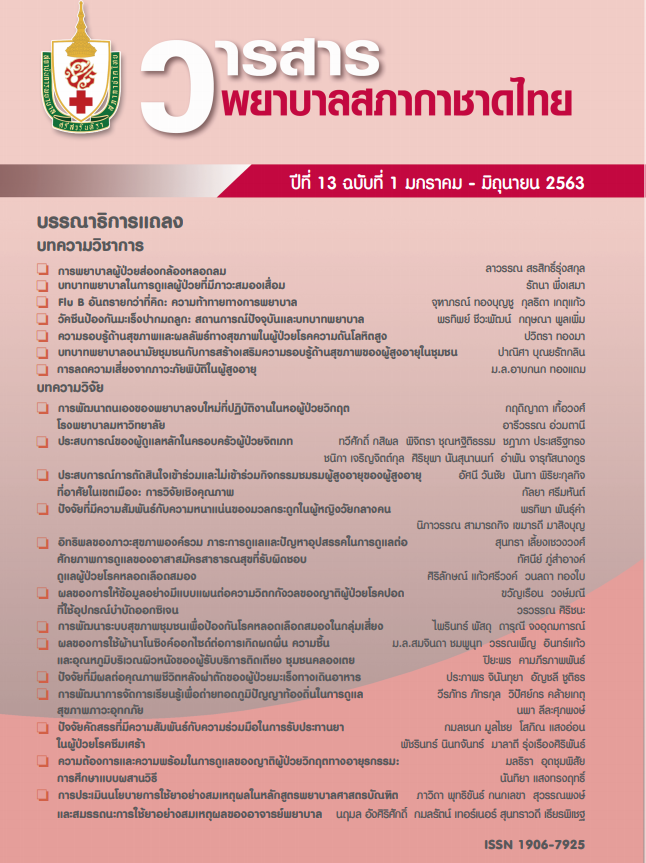Influenza B Dangerous Than Thought: Challenge Dimension in Nursing
Keywords:
influenza B, encephalitis, hypoxiaAbstract
Many people believe that the influenza virus type B is not dangerous because it provokes fewer symptoms of fever and less severity of pneumonia than influenza A. Consequently, when infected with influenza B, many are not prompted to take adequate care of their own health. This can lead to dangerous complications or may develop into physical. This article presents a case study of a strong 13 year old swimmer who suffered infection from influenza B. On the first day, she felt she was starting to catch a cold. However, she continued to swim. The girl was confident in the strength of her body. Finally, this condition made her encounter a terrible alteration. She ended up in the hospital for 4 weeks because of viral encephalitis. After leaving the hospital, she had to visit the outpatient department for initial evaluation, treatment and rehabilitation of dysphagia, wry mouth, and numbness on right side of her body which still remains. The follow-up appointment came 6 months later before when all abnormalities were finally cured. This article also presents information about infulenza virus differentiation, details signs, symptoms and complications, and examines laboratory investigations and medication. This article may prove useful for nurses to adjust nursing plans suitable for patients.
References
2. Jorgensen JH, Pfaller MA, Carroll KC, Funke G, Landr ML, Richter SS, Warnock DW, editors. Manual of clinical microbiology. 11th ed. Washington: ASM Press; 2015.
3. King AMQ, Adams MJ, Carstens EB, Lefkowitz EJ, editors. Virus taxonomy, classification and nomenclature of viruses, ninth report of the International Committee on Taxonomy of Viruses. London; Academic Press; 2001.
4. Shtyrya YA, Mochalova LV, Bovin NV. Influenza virus neuraminidase: structure and function. Acta Naturae 2009;1(2):26-32.
5. Sautto GA, Kirchenbaum GA, Ross TM. Towards a universal influenza vaccine: different approaches for one goal. Virol J 2018;15(1):17.
6. Tokars JI, Olsen SJ, Reed C. The seasonal incidence of symptomatic influenza in the United States. Clin Infect Dis. 2018;66(10):1511-8.
7. Cox MM, Izikson R, Post P, Dunkle L. Safety, efficacy, and immunogenicity of Flublok in the prevention of seasonal influenza in adults. Ther Adv Vaccines 2015;3(4):97-108.
8. Watanabe T, Kawakami E, Shoemaker JE, Lopes TJ, Matsuoka Y, Tomita Y, et al. Influenza virus-host interactome screen as a platform for antiviral drug development. Cell Host Microbe 2014;16(6):795-805.
9. Wright P. “Influenza virus.” In: Behrman RE, Kliegman RM, Jenson HR, editors, Nelson textbook of pediatrics, 17th ed. Philadelphia: Saunders; 2004. p. 1072-5.
10. Huang SSH, Banner D, Paquette SG, Leon AJ, Kelvin AA, Kelvin DJ. Pathogenic influenza B virus in the ferret model establishes lower respiratory tract infection. J Gen Virol 2014;95 (Pt 10):2127-39.
11. Kawada J, Kimura H, Ito Y, Hara S, Iriyama M, Yoshikawa T, Morishima T. Systemic cytokine responses in patients with influenza-associated encephalopathy. J Infect Dis 2003;188(5):690-8
12. Morishima T, Togashi T, Yokota S, Okuno Y, Miyazaki C, Tashiro M, Okabe N. Encephalitis and encephalopathy associated with an influenza epidemic in Japan. Clin Infect Dis 2002;35(5):512-7.
13. Yokota S, Imagawa T, Miyamae T, Ito S, Nakajima S, Nezu A, Mori M. Hypothetical pathophysiology of acute encephalopathy and encephalitis related to influenza virus infection and hypothermia therapy. Pediatr Int 2000;42(2):197-203.
14. Baghbanian SM. Influenza vaccination in patients with multiple sclerosis is possible with some considerations. Iran J Neurol 2016;15(2):109-10.
15. Iwasaki H. Influenza-associated intrapelvic myositis in an elderly person presenting with gait disturbance. BMJ Case Rep 2019;12(5): pii: e229355. doi: 10.1136/bcr-2019-229355.
16. Britton PN, Dale RC, Blyth CC, Macartney K, Crawford NW, Marshall H, et al. Influenza-associated Encephalitis/Encephalopathy Identified by the Australian Childhood Encephalitis Study 2013-2015. Pediatr Infect Dis J 2017;36(11):1021-6.
17. Goenka A, Michael BD, Ledger E, Hart IJ, Absoud M, Chow G, et al. Neurological manifestations of influenza infection in children and adults: results of a National British Surveillance Study. Clin Infect Dis 2014;58(6):775-84.
18. Hubbard K, Pellar G, Emanuel P. Suitability of Commercial Transport Media for Biological Pathogens under Nonideal Conditions. Int J Microbiol 2011; 2011: 463096. doi: 10.1155/2011/463096
19. Ignatavicius DD, Workman ML, Rebar CR. Medical-surgical nursing: concepts for interprofessional collaborative care. 9th ed. St. Louis: Elsevier; 2018
20. Huether SE, McCance KL. Understanding pathophysiology. 6th ed. St. Louis: Elsevier; 2017.
21. Skidmore-Roth L. Mosby's 2018 nursing drug reference. 31st ed. St. Louis: Elsevier. Mosby; 2018.
22. Tamez-Pérez HE, Quintanilla-Flores DL, Rodríguez-Gutiérrez R, González-González JG, Tamez-Peña AL. Steroid hyperglycemia: prevalence, early detection and therapeutic recommendations: a narrative review. World J Diabetes 2015;6(8):1073-81.
Downloads
Published
Issue
Section
License
เนื้อหาบทความหรือข้อคิดเห็นต่างๆ ในวารสารพยาบาลสภากาชาดไทยนี้ เป็นความคิดเห็นของผู้เขียนบทความ ไม่ใช่ความเห็นของกองบรรณาธิการ หรือสถาบันการพยาบาลศรีสวรินทิรา สภากาชาดไทย






